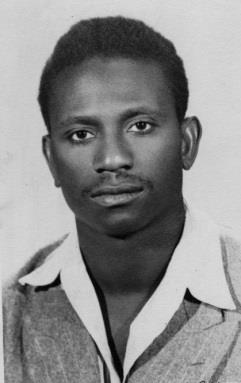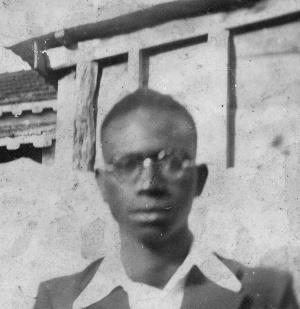Cheikh Anta Diop facts for kids
Quick facts for kids
Cheikh Anta Diop
|
|
|---|---|

Diop as a university student in Paris in the late 1940s
|
|
| Born |
Seex Anta Jóob (in wolof)
29 December 1923 |
| Died | 7 February 1986 (aged 62) |
| Nationality | Senegalese |
| Occupation | Historian, anthropologist, physicist, politician |
Cheikh Anta Diop (29 December 1923 – 7 February 1986) was a Senegalese historian, anthropologist, physicist, and politician who studied the human race's origins and pre-colonial African culture. Diop's work is considered foundational to the theory of Afrocentricity, though he himself never described himself as an Afrocentrist. The questions he posed about cultural bias in scientific research contributed greatly to the postcolonial turn in the study of African civilizations.
Diop argued that there was a shared cultural continuity across African people that was more important than the varied development of different ethnic groups shown by differences among languages and cultures over time. Some of his ideas have been criticized as based upon outdated sources and an outdated conception of race. Other scholars have defended his work from what they see as widespread misrepresentation.
Cheikh Anta Diop University (formerly known as the University of Dakar), in Dakar, Senegal, is named after him.
Contents
Early life
Born in Thieytou, Diourbel Region, Senegal, Diop belonged to an aristocratic Muslim Wolof family in Senegal where he was educated in a traditional Islamic school. Diop's family was part of the Mouride brotherhood, the only independent Muslim fraternity in Africa according to Diop. He obtained the colonial equivalent of the metropolitan French baccalauréat in Senegal before moving to Paris to study for a degree.
Studies in Paris
In 1946, at the age of 23, Diop went to Paris to study. He initially enrolled to study higher mathematics, but then enrolled to study philosophy in the Faculty of Arts of the University of Paris. He gained his first degree (licence) in philosophy in 1948, then enrolled in the Faculty of Sciences, receiving two diplomas in chemistry in 1950.
In 1948 Diop edited with Madeleine Rousseau, a professor of art history, a special edition of the journal Musée vivant, published by the Association populaire des amis des musées (APAM). APAM had been set up in 1936 by people on the political left wing to bring culture to wider audiences. The special edition of the journal was on the occasion of the centenary of the abolition of slavery in the French colonies and aimed to present an overview of issues in contemporary African culture and society. Diop contributed an article to the journal: "Quand pourra-t-on parler d'une renaissance africaine" (When we will be able to speak of an African Renaissance?). He examined various fields of artistic creation, with a discussion of African languages, which, he said, would be the sources of regeneration in African culture. He proposed that African culture should be rebuilt on the basis of ancient Egypt, in the same way that European culture was built upon the legacies of ancient Greece and Rome.
In 1949, Diop registered a proposed title for a Doctor of Letters thesis, "The Cultural Future of African thought," under the direction of Professor Gaston Bachelard . In 1951 he registered a second thesis title "Who were the pre-dynastic Egyptians" under Professor Marcel Griaule.
In 1953, he first met Frédéric Joliot-Curie, Marie Curie's son-in-law , and in 1957 Diop began specializing in nuclear physics at the Laboratory of Nuclear Chemistry of the College de France which Frederic Joliot-Curie ran until his death in 1958 , and the Institut Pierre et Marie Curie in Paris. He ultimately translated parts of Einstein's Theory of Relativity into his native Wolof.
According to Diop's own account, his education in Paris included History, Egyptology, Physics, Linguistics, Anthropology, Economics, and Sociology. In Paris, Diop studied under André Aymard , professor of History and later Dean of the Faculty of Letters at the University of Paris and he said that he had "gained an understanding of the Greco-Latin world as a student of Gaston Bachelard, Frédéric Joliot-Curie, André Leroi-Gourhan, and others".
In his 1954 thesis, Diop argued that ancient Egypt had been populated by Black people. He specified that he used the terms "negro", "black", "white" and "race" as "immediate givens" in the Bergsonian sense, and went on to suggest operational definitions of these terms. He said that the Egyptian language and culture had later been spread to West Africa. When he published many of his ideas as the book Nations nègres et culture (Negro Nations and Culture), it made him one of the most controversial historians of his time.
In 1956 he re-registered a new proposed thesis for Doctor of Letters with the title "The areas of matriarchy and patriarchy in ancient times." From 1956, he taught physics and chemistry in two Paris lycees as an assistant master, before moving to the College de France. In 1957 he registered his new thesis title "Comparative study of political and social systems of Europe and Africa, from Antiquity to the formation of modern states." The new topics did not relate to ancient Egypt but were concerned with the forms of organisation of African and European societies and how they evolved. He obtained his doctorate in 1960.
Career
Diop served as a member of the UNESCO International Scientific Committee for the Drafting of a General History of Africa in 1971 and wrote the opening chapter about the origins of the ancient Egyptians in the UNESCO General History of Africa. In this chapter, he presented anthropological and historical evidence in support of his hypothesis that Ancient Egyptians had a close genetic affinity with Sub-Saharan African ethnic groups, including a shared B blood group between modern Egyptians and West Africans, "negroid" bodily proportions in ancient Egyptian art and mummies, microscopic analysis of melanin levels in mummies from the laboratory of the Musée de L’Homme in Paris, primary accounts of Greek historians, and shared cultural linkages between Egypt and Africa in areas of totemism and cosmology. At the symposium Diop's conclusions were met with an array of responses, from strong objections to enthusiastic support.
See also
 In Spanish: Cheikh Anta Diop para niños
In Spanish: Cheikh Anta Diop para niños


